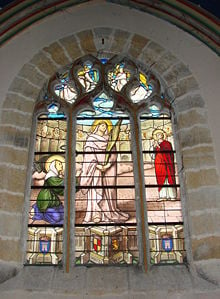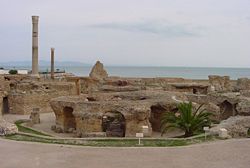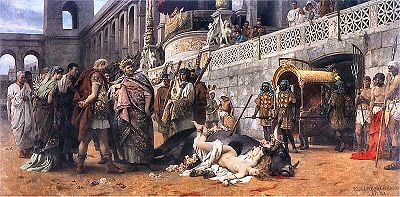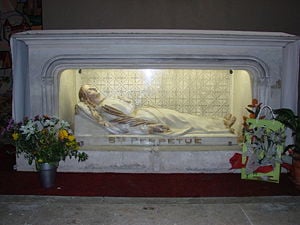Difference between revisions of "Perpetua and Felicity" - New World Encyclopedia
m (→Legacy) |
m (→Legacy) |
||
| Line 84: | Line 84: | ||
[[Image:Rosa 'Felicite et Perpetue'.jpg|thumb|left|The rose "Felicite et Perpetue"]] | [[Image:Rosa 'Felicite et Perpetue'.jpg|thumb|left|The rose "Felicite et Perpetue"]] | ||
| − | When Saint [[Thomas Aquinas]] was inserted into the Roman calendar on the same day, the celebration of Felicitas and Perpetua was downgraded to a mere commemoration until 1908, when [[Pope Pius X]] brought the date for celebrating them forward to 6 March. In 1969, [[Pope Paul VI]] restored the date of their celebration to March 7.<ref>C''alendarium Romanum'' (Libreria Editrice Vaticana, 1969), pp. 89, 119</ref> [[Traditionalist Catholic]]s still observe March 6 as their feast. Other Churches also, including the [[Lutheran Church]] and the [[Episcopal Church in the United States of America|Episcopal Church]], commemorate these two martyrs on March 7. | + | When Saint [[Thomas Aquinas]] was inserted into the Roman calendar on the same day, the celebration of Felicitas and Perpetua was downgraded to a mere commemoration until 1908, when [[Pope Pius X]] brought the date for celebrating them forward to 6 March. In 1969, [[Pope Paul VI]] restored the date of their celebration to March 7.<ref>C''alendarium Romanum'' (Libreria Editrice Vaticana, 1969), pp. 89, 119</ref> [[Traditionalist Catholic]]s still observe March 6 as their feast. Other Churches also, including the [[Eastern Orthodox]] Church, [[Lutheran Church]] and the [[Episcopal Church in the United States of America|Episcopal Church]], commemorate these two martyrs on March 7. |
The rambling rose "Félicité et Perpétue" (''R. sempervirens'', also known as "Old Blush," with palest pink buds opening nearly white, was introduced by Robert Jacques, director of horticulture for King [[Louis-Philippe of France|Louis-Philippe]], in 1828. | The rambling rose "Félicité et Perpétue" (''R. sempervirens'', also known as "Old Blush," with palest pink buds opening nearly white, was introduced by Robert Jacques, director of horticulture for King [[Louis-Philippe of France|Louis-Philippe]], in 1828. | ||
Revision as of 00:01, 22 October 2008
| Saints Perpetua and Felicity | |
|---|---|
Perpetua (center) and Felicity (left) with fellow saint before their martyrdom | |
| Martyrs | |
| Died | 7 March 202 or 203 in Carthage, Roman Province of Africa |
| Venerated in | Roman Catholic Church, Eastern Orthodox Churches, Oriental Orthodox Churches, Anglican Communion, Lutheran Church |
| Feast | 7 March (6 March from 1908 to 1969) |
| Patronage | Mothers, Expectant Mothers |
- Perpetua redirects here. For other uses, see Perpetua (disambiguation)
- For the other saint named Felicitas, see Felicitas of Rome.
Saints Perpetua and Felicitas are two early century Christian martyrs venerated as saints. Perpetua was a 22-year old married noblewoman and nursing mother, while her co-martyr Felicitas (or Felicity), an expectant mother, was her slave. They suffered at Carthage, Roman Province of Africa around 203 C.E., together with several other martyrs to their faith. The record of the Passion of St. Perpetua, St. Felicitas, and their Companions is considered one of the great treasures of Christian literature, believed to preserve the actual words of the martyrs and their friends.
During the persecutions of the Emperor Septimius Severus, five catechumens (candidates for Christian baptism) were arrested for their faith. The group consisted of a slave named Revocatus, his fellow slave Felicitas, two free men named Saturninus and Secundulus, and Vivia Perpetua, the wife of a nobleman who was the mother of an infant. Perpetua's father was a pagan, her mother and two brothers were Christians, and one of the brothers, like her, was a catechumen.
The five prisoners were soon joined by Saturus, who seems to have been their instructor in the faith who chose to share their punishment. At first they were all kept under strict guard in a private house. Perpetua wrote a vivid account of the events leading up to their martyrdom. Their sufferings while in prison, the angry attempts of Perpetua's father to induce her to renounce Christianity, the vicissitudes of the martyrs before their execution, and the visions of Saturus and Perpetua in their dungeons, were all committed to writing.
Recent studies indicated that the martyrs may have been Montanists, a "heretical" sect with a strong following in Carthage, but the are universally recognized as orthodox saints.
History
The date of their martyrdom of Perpetua and Felicitas is traditionally given as March 6, 203.[1] The details of the martyrdoms survive in both Latin and Greek texts. Perpetua's account is apparently historical, making it is the earliest surviving text written by a Christian woman.[2] After a brief introduction (chapters i–ii), the narrative and visions of Perpetua (iii–x) are followed by the vision of Saturus (xi–xiii). After this, the account of their deaths, written by an eyewitness, are appended (xiv–xxi).
By order of Emperor Septimius Severus (193–211), all imperial subjects were forbidden under severe penalties to become Christians or Jews. The edict did not affect earlier converts, but only recent ones.[3] As a result, the five new Christians and catechumens were seized and cast into prison. Before being led away, the catechumens were baptized.
According to Perpetua's Acts, the terrors of imprisonment were increased by her anxiety for her unweaned child. Two deacons succeeded in gaining admittance to her prison by bribing the jailer, and Perpetua's mother brought the baby to her. She was then permitted to nurse the child and keep it with her. She relates: "Straightway I became well and was lightened of my labor and care for the child; and suddenly the prison was made a palace for me."
A vision informed her of her approaching martyrdom. Perpetua saw herself treading on a dragon's head and ascending a perilous bronze ladder leading to green meadows, where a flock of sheep was grazing. A few later Perpetua's father, hearing that the trial of the imprisoned Christians would soon take place, visited their dungeon and besought her not to bring this disgrace on their name; but Perpetua remained steadfast. The next day the trial of the six took place before the Procurator Hilarianus. All six resolutely confessed their Christian faith. Perpetua's father, carrying her child in his arms, approached her again and attempted to induce her to apostatize. The procurator also remonstrated with her, but in vain, as she steadfastly refused to offer sacrifice to the gods. The procurator then had the father removed by force.
The Christians were then condemned to be torn to pieces by wild beasts. As was the case with many such martyrs, they responded to their sentences by giving thanks to God for sharing in the suffering of Jesus.
In another vision, recorded while awaiting her sentence to be carried out, Perpetua saw her brother Dinocrates, who had died unbaptized from a disfiguring disease at the early age of seven, in a place of darkness and distress. She prayed for him and later had a vision of him happy and healthy, his disfigurement only a scar. In another apparition, she apparently saw herself defeating a savage Egyptian, interpreting this that she would have to do battle not merely with wild beasts but with the Devil himself.
Saturus, who also recorded his visions, saw himself and Perpetua transported Eastward by four angels to a beautiful garden, where they met in the spirit with four other North African Christians who had suffered martyrdom during the same persecution. Saturus also saw in this vision Bishop Optatus of Carthage and the priest Aspasius, who besought the martyrs to arrange a reconciliation between the two churchmen.
Meanwhile, the birthday of Emperor Geta approached, on which occasion the condemned Christians were to fight with wild beasts in the military games. They were therefore transferred to the prison in the camp.
Perpetua had another significant vision as well, which repeated the first. In this vision, Perpetua saw a ladder leading to heaven. At the bottom of the ladder was a serpent, attacking the Christians trying to climb the latter to heaven. From this vision Perpetua claimed that she would have to fight Satan rather than just the beast of the arena. Furthermore, she learned that she would not be defeated in her quest and was defiantly confident.
Meanwhile, their jailer, Pudens, had come to respect his prisoners, and he permitted other Christians to visit them. Perpetua's father was also admitted and made another fruitless attempt to dissuade his daughter from her impending matyrdom.
One of the martyrs, Secundulus, then died in prison. Felicitas, who was eight months pregnant, was apprehensive that she would not be permitted to suffer martyrdom with the others, since the law forbade the execution of pregnant women. However, two days before the games, she gave birth to a daughter, who was adopted by a Christian woman.
On the day of the games, the five were led into the amphitheater. At the demand of the crowd they were first scourged. Then a boar, a bear, and a leopard, were set on the men, and a wild bull on the women. Wounded by the wild animals, they gave each other the kiss of peace and were then put to the sword.
A narrator adds: "But Perpetua, that she might have some taste of pain, was pierced between the bones and shrieked out; and when the swordsman's hand wandered still (for he was a novice), herself set it upon her own neck. Perchance so great a woman could not else have been slain (being feared of the unclean spirit) had she not herself so willed it."
Their bodies were interred at Carthage.
Legacy
Perpetua’s diary, the first known writing vy a Christian woman was highly respected in the churches of Carthage’s and was appealed to both by "orthodox" Christians and "heretical" Montanists alike. Indeed, the fact that Montanists were known to prefer martyrdom has lead some recent scholars to suggest that Perpetua and Felicity may have been Montanists themselves.
In Carthage a magnificent basilica was later erected over the tomb of the martyrs, where an ancient inscription bearing the names of Perpetua and Felicitas has been found.
In Roman Catholic tradition, Saints Felicitas and Perpetua are two of seven women commemorated by name in the Canon of the Mass. The feast day of Perpetua and Felicitas, March 7, soon came to be celebrated even outside Africa, and by the fourth-century these African martyrs were venerated publicly at Rome. Augustine of Hippo (354–430) wrote sermons expanding on the young Saint Perpetua's words.
The account of St. Perpetua comforting her dead brother Dinocrates became a point of controvesy, as it bolstered the claim that unbaptized infants could attain paradise, or even heaven. Augustine, however, rejected this notion, insisting that Jesus' atoning sacrifice was efficacious only for baptized Christians. Therefore proposed that even though Peretua stated that Dinocrates was not a Christian, he could have once been baptized but later estranged from Christ by his pagan father. The story later became an important example in the development of the doctrine of purgatory.[4]
When Saint Thomas Aquinas was inserted into the Roman calendar on the same day, the celebration of Felicitas and Perpetua was downgraded to a mere commemoration until 1908, when Pope Pius X brought the date for celebrating them forward to 6 March. In 1969, Pope Paul VI restored the date of their celebration to March 7.[5] Traditionalist Catholics still observe March 6 as their feast. Other Churches also, including the Eastern Orthodox Church, Lutheran Church and the Episcopal Church, commemorate these two martyrs on March 7.
The rambling rose "Félicité et Perpétue" (R. sempervirens, also known as "Old Blush," with palest pink buds opening nearly white, was introduced by Robert Jacques, director of horticulture for King Louis-Philippe, in 1828.
Notes
- ↑ However, some argue that the association of their martyrdom with a birthday festival of the future Emperor Geta would seem to place it after 209, when Geta was made Caesar, though before 211, when he was assassinated.
- ↑ Paul Halsall ed. Internet Medieval Sourcebook
- ↑ Dale Irvin and Scott Sunquist, History of World Christian Movement (Orbis Books. Maryknoll, NY, 2001), 82-83
- ↑ Church Fathers Volume 14 Augustin. www.catholicfirst.com. Retrieved October 21, 2008.
- ↑ Calendarium Romanum (Libreria Editrice Vaticana, 1969), pp. 89, 119
ReferencesISBN links support NWE through referral fees
- Butler, Rex. The New Prophecy and "New Visions": Evidence of Montanism in the Passion of Saints Perpetua and Felicitas. Washington DC: Catholic University of America Press, 2006. ISBN 0813214556
- Maitland, Sara. The Martyrdom of Perpetua. Evesham: Arthur James, 1996. ISBN 0853053529
- Nolan, Edward. Cry Out and Write: A Feminine Poetics of Revelation. New York: Continuum, 1994. ISBN 082640684X
- Robeck, Cecil. Prophecy in Carthage: Perpetua, Tertullian and Cyprian. Cleveland: Pilgrim Press, 1992. ISBN 0829809244
- Salisbury, Joyce. Perpetua's Passion. New York: Routledge, 1997. ISBN 0415918375
- Von Franz, Marie-Luise. The Passion of Perpetua: A Psychological Interpretation of Her Visions. Toronto: Inner City Books, 2004. ISBN 1894574117
External links
- Martyrdom of Perpetua and Felicity. www.fordham.edu
- Henry Wace, A Dictionary of Christian Biography and Literature to the End of the Sixth Century C.E.. www.ccel.org
- Patron Saints Index: St. Felicity. catholic-forum.com
Template:Famous Carthaginians
Credits
New World Encyclopedia writers and editors rewrote and completed the Wikipedia article in accordance with New World Encyclopedia standards. This article abides by terms of the Creative Commons CC-by-sa 3.0 License (CC-by-sa), which may be used and disseminated with proper attribution. Credit is due under the terms of this license that can reference both the New World Encyclopedia contributors and the selfless volunteer contributors of the Wikimedia Foundation. To cite this article click here for a list of acceptable citing formats.The history of earlier contributions by wikipedians is accessible to researchers here:
The history of this article since it was imported to New World Encyclopedia:
Note: Some restrictions may apply to use of individual images which are separately licensed.





